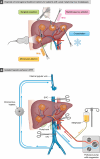Management of liver metastases from uveal melanoma
- PMID: 40794619
- PMCID: PMC12485227
- DOI: 10.1093/bjs/znaf130
Management of liver metastases from uveal melanoma
Abstract
Uveal melanoma is the most common primary intraocular malignancy in adults, with distinct genetic and clinical characteristics compared with cutaneous melanoma. Despite improvements in the treatment of the primary tumour, nearly half of the patients will develop distant metastases, most commonly in the liver. Once metastases are detected, the median overall survival is approximately 1 year, with a 2-year survival rate of only 8%. Systemic treatment, including chemotherapy, immunotherapy, and targeted therapy, has historically shown limited efficacy. The first (and so far only) systemic treatment to demonstrate an improvement in overall survival is tebentafusp, which is now approved for treatment of patients with metastatic or unresectable uveal melanoma and an HLA-A*02:01 genotype. Liver-directed therapies include surgical resection, radioembolization, chemoembolization, immune-embolization, isolated hepatic perfusion, and percutaneous hepatic perfusion. This review discusses the clinical background of uveal melanoma and liver metastasis, the efficacy of systemic and locoregional treatment options, and the promising development of combining locoregional liver-directed treatment with systemic treatment.
© The Author(s) 2025. Published by Oxford University Press on behalf of BJS Foundation Ltd.
Figures




References
-
- Bergman L, Seregard S, Nilsson B, Ringborg U, Lundell G, Ragnarsson-Olding B. Incidence of uveal melanoma in Sweden from 1960 to 1998. Invest Ophthalmol Vis Sci 2002;43:2579–2583 - PubMed
-
- McLaughlin CC, Wu XC, Jemal A, Martin HJ, Roche LM, Chen VW. Incidence of noncutaneous melanomas in the U.S. Cancer 2005;103:1000–1007 - PubMed
-
- Singh AD, Turell ME, Topham AK. Uveal melanoma: trends in incidence, treatment, and survival. Ophthalmology 2011;118:1881–1885 - PubMed
Publication types
MeSH terms
LinkOut - more resources
Full Text Sources
Medical
Research Materials

